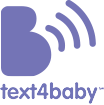Learn More About Your Pregnancy
Baby's First Foods
Feeding your baby solid foods
Generally, when infants double their birth weight (typically at around 6 months) and weigh about 13 pounds or more, they may be ready for solid foods.
- Signs that your baby may be ready include being able to control their head and neck, sitting up alone or with support, brining objects to their mouths, trying to grasp small objects, such as toys or food, and swallowing food rather than pushing it back out onto the chin.
- Babies may be ready if they watch you eating, and open their mouth, showing you that they want to try and eat your food.
- When you’re ready to start feeding, stay with your baby the whole time, watching for signs of choking.
- Still not sure if your infant is ready? Your baby’s four- or six-month well-child visit is a great time to have a conversation with your pediatrician about introducing solid foods.
What do I feed my baby?
Start with one food first. Examples include baby cereal and pureed vegetable or fruit. Baby cereals are available premixed in individual containers or dry, to which you can add breast milk, formula, or water. Babies who are breastfed ideally need beef, other types of meat or an iron fortified cereal. NOTE: Do not put baby cereal in a bottle. This can cause your baby to choke. It also may increase the amount of food your baby eats and cause them to gain too much weight. It is possible that your child’s provider may recommend cereal in a bottle if your baby has reflux.
Gradually offer new single ingredient purees one at a time. First, offer thin purees, advancing to mashed consistencies as your baby’s palate adjusts to different textures. When ready, you can progress your baby’s diet by serving two-ingredient purees such as meat mixed with a vegetable. If your baby is primarily breastfed, you may consider feeding your baby beef or other types of meat, which are rich sources of dietary iron that your baby needs to grow. Iron-fortified whole grain cereals like baby oatmeal are also options. Check with your baby’s doctor.
How do I feed my baby?
Allow your baby to sample small amounts of purees first, introducing one new food at a time. Start with half a spoonful or less and talk to your baby through the process (‘Mmm, see how good this is?’). Your baby may not know what to do at first. She may look confused, wrinkle her nose, roll the food around her mouth, or reject it altogether. One way to make eating solids for the first time easier is to give your baby a little breast milk and/or formula first, then switch to very small half-spoonfuls of food, and finish with more breast milk and/or formula. This will prevent your baby from getting frustrated when s/he is very hungry. Be patient, your baby may need to be offered a new food many times before accepting this food; don’t give up!
When feeding your baby food, continue to provide breast milk or formula, primary sources of infant nutrition, until your baby turns one year old. You can continue to breastfeed after 12 months if you and your baby desire. Avoid cow’s milk as a beverage (but may be mixed with food), fruit juice, or honey until your baby turns one year old.
When can baby try other foods?
Once your baby learns to eat one food, gradually give them other foods. Within a few months of starting solid foods, your baby’s daily diet should include a variety of foods each day that may include the following:
- Breast milk and/or formula.
- Cereal.
- Vegetables.
- Fruits.
- Protein foods, including meats, poultry, eggs, seafood, fish, nuts, seeds, and soy products.
Note: If you make your own baby food, be aware that home-prepared spinach, beets, green beans, squash, and carrots are not recommended until your baby is at least six months old due to their high nitrate content. They may contain large amounts of nitrates.
Once these first foods have been successfully added into your baby’s diet, you can then move onto foods that can commonly trigger allergies, like peanuts. Research now shows that introducing peanuts to your infant early (see: Adding Peanut Foods to Baby’s Diet) can help reduce the risk of peanut allergy for your baby. However, before you get started, it’s important to note that some babies may be more likely to have a food allergy. For instance, if your baby has severe eczema or an egg allergy, wait to give peanut-containing foods until your doctor says it is okay.

